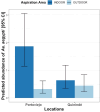Behaviour and distribution of Aedes aegypti mosquitoes and their relation to dengue incidence in two transmission hotspots in coastal Ecuador
- PMID: 38683840
- PMCID: PMC11081501
- DOI: 10.1371/journal.pntd.0010932
Behaviour and distribution of Aedes aegypti mosquitoes and their relation to dengue incidence in two transmission hotspots in coastal Ecuador
Abstract
Background: Dengue (DENV) transmission is endemic throughout coastal Ecuador, showing heterogeneous incidence patterns in association with fine-scale variation in Aedes aegypti vector populations and other factors. Here, we investigated the impact of micro-climate and neighbourhood-level variation in urbanization on Aedes abundance, resting behaviour and associations with dengue incidence in two endemic areas.
Methodology/principal findings: Aedes aegypti were collected in Quinindé and Portoviejo, two urban cantons with hyperendemic dengue transmission in coastal Ecuador. Aedes vectors were sampled in and around houses within urban and peri-urban neighbourhoods at four time periods. We tested for variation in vector abundance and resting behaviour in relation to neighbourhood urbanization level and microclimatic factors. Aedes abundance increased towards the end of the rainy season, was significantly higher in Portoviejo than in Quinindé, and in urban than in peri-urban neighbourhoods. Aedes vectors were more likely to rest inside houses in Portoviejo but had similar abundance in indoor and outdoor resting collections in Quinindé. Over the study period, DENV incidence was lower in Quinindé than in Portoviejo. Relationships between weekly Ae. aegypti abundance and DENV incidence were highly variable between trapping methods; with positive associations being detected only between BG-sentinel and outdoor Prokopack collections.
Conclusions/significance: Aedes aegypti abundance was significantly higher in urban than peri-urban neighbourhoods, and their resting behaviour varied between study sites. This fine-scale spatial heterogeneity in Ae. aegypti abundance and behaviour could generate site-specific variation in human exposure and the effectiveness of indoor-based interventions. The trap-dependent nature of associations between Aedes abundance and local DENV incidence indicates further work is needed to identify robust entomological indicators of infection risk.
Copyright: © 2024 Ortega-López et al. This is an open access article distributed under the terms of the Creative Commons Attribution License, which permits unrestricted use, distribution, and reproduction in any medium, provided the original author and source are credited.
Conflict of interest statement
The authors have declared that no competing interests exist.
Figures






Similar articles
-
The mosquito electrocuting trap as an exposure-free method for measuring human-biting rates by Aedes mosquito vectors.Parasit Vectors. 2020 Jan 15;13(1):31. doi: 10.1186/s13071-020-3887-8. Parasit Vectors. 2020. PMID: 31941536 Free PMC article.
-
Dengue and yellow fever virus vectors: seasonal abundance, diversity and resting preferences in three Kenyan cities.Parasit Vectors. 2017 Dec 29;10(1):628. doi: 10.1186/s13071-017-2598-2. Parasit Vectors. 2017. PMID: 29284522 Free PMC article.
-
Salinity tolerant Aedes aegypti and Ae. albopictus-Infection with dengue virus and contribution to dengue transmission in a coastal peninsula.J Vector Borne Dis. 2018 Jan-Mar;55(1):26-33. doi: 10.4103/0972-9062.234623. J Vector Borne Dis. 2018. PMID: 29916445
-
Surveillance of Aedes aegypti indoors and outdoors using Autocidal Gravid Ovitraps in South Texas during local transmission of Zika virus, 2016 to 2018.Acta Trop. 2019 Apr;192:129-137. doi: 10.1016/j.actatropica.2019.02.006. Epub 2019 Feb 11. Acta Trop. 2019. PMID: 30763563
-
Dengue-1 virus and vector competence of Aedes aegypti (Diptera: Culicidae) populations from New Caledonia.Parasit Vectors. 2017 Aug 9;10(1):381. doi: 10.1186/s13071-017-2319-x. Parasit Vectors. 2017. PMID: 28793920 Free PMC article.
References
Publication types
MeSH terms
LinkOut - more resources
Full Text Sources
Medical

